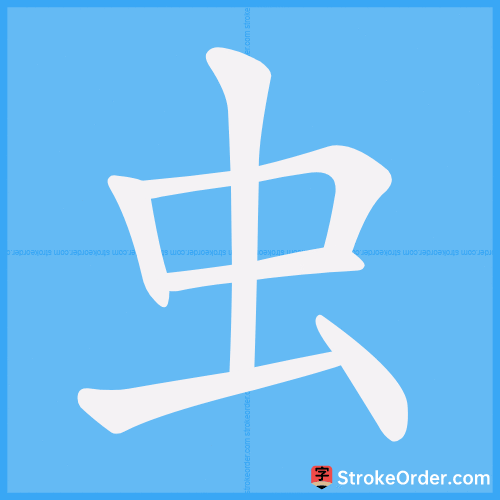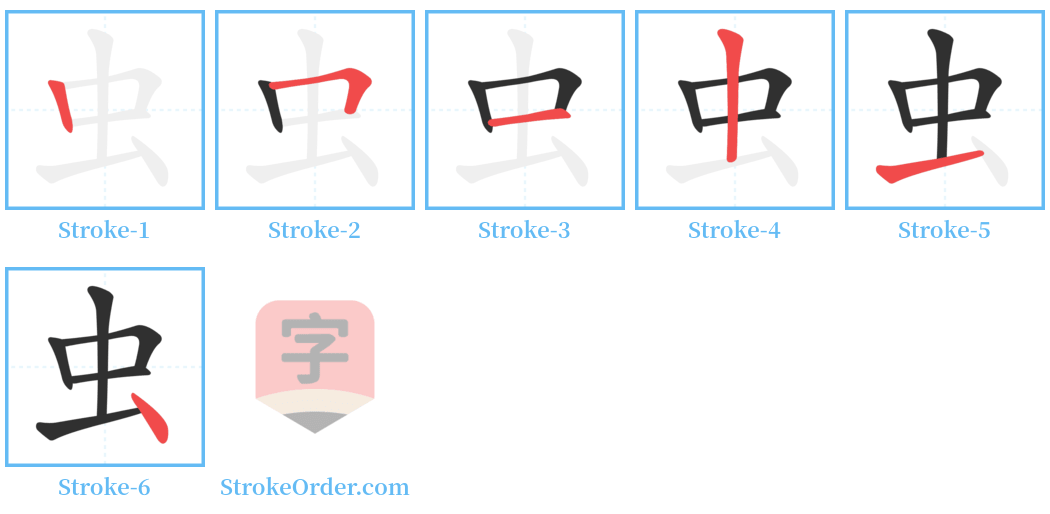虫 Stroke Order
Animated Stroke Order of 虫

Stroke Order Diagrams for 虫

Step-by-Step Handwriting Guide for 虫

Learn to Write Chinese Characters with Video Tutorials
Watch the video of writing the Chinese character "虫", learn the correct stroke order (笔顺) of the character "虫", and master the standard way of writing the character "虫".
Free Printable Handwriting Practice with Stroke Order: 虫
Printable Writing Practice Worksheet of "虫" in Portrait Orientation (Tian Zi Ge)

Printable Writing Practice Worksheet of "虫" in Landscape Orientation (Tian Zi Ge)

Information of 虫
Pinyin
chóng、 huǐ
Radical
虫
Strokes
6 strokes
Usage
★★★★★
Definition
insect / worm, an animal / an invertebrate / a worm / an insect
虫
(chóng)
[ noun ]
1. A class of arthropods.
(节肢动物的一类。)
2. The general term for animals.
(动物的通称。)
Detailed Meanings:
1. A class of arthropods: e.g. insects, beneficial bugs, minor skills (metaphor for insignificant skills).
(节肢动物的一类:昆虫。益虫。雕虫小技(喻微不足道的技能)。)
2. The general term for animals: e.g. big bugs (tigers), long bugs (snakes), shelled bugs (insects with shells).
(动物的通称:大虫(老虎)。长虫(蛇)。介虫(有介壳的虫子)。)
- Primary meaning: General term for insects.
(【本义】:昆虫的通称)
- Formation: Pictographic. It is one of the radicals in Chinese characters, with characters that often relate to insects, snakes, etc. The character "虫" in oracle bone script resembles a snake; originally read as huǐ, referring to a type of venomous snake. It later became the simplified form of "蟲".
(【造字法】:象形。汉字部首之一,从“虫”的字多与昆虫、蛇等有关。按:“虫”甲骨文字形象蛇形,本读 huǐ,即虺,是一种毒蛇。后为“蟲”的简体。)
Synonyms:
1. Same as the primary meaning ([En.] insect).
(同本义 ([En.] insect))
2. In ancient times, it referred broadly to all animals ([En.] animal).
(古代泛指所有的动物 ([En.] animal))
3. Insect plagues ([En.] plague of insects).
(虫灾 ([En.] plague of insects)。)
Examples:
- In ancient literature, "虫" refers to animals: e.g., in "Shuowen Jiezi," it mentions that creatures with legs are called "虫," while those without legs are referred to as "豸."
(【引】1 《说文》:虫,有足谓之虫,无足谓之豸。)
- "The wind is an insect," in "Confucius' Family Sayings."
(【引】2 《孔子家语·执辔》:风为虫。)
- "Annoyances manifest as insects" in "Huainanzi."
(【引】3 《淮南子·精神》:烦气为虫。)
- Biblical text: "Birds, beasts, and insects" in "Liezi."
(【引】4 《列子·黄帝》:禽兽虫蛾。)
- "Insects buzz and fly" in "Book of Songs."
(【引】5 《诗·齐风·桑柔》:虫飞薨薨。)
- Historical observation of nature: "The ancients observed the natural world, mountains, rivers, plants, insects, fish, and birds."
(【引】6 王安石《游褒禅山记》:古人之观于天地、山川、草木、虫鱼、鸟兽,往往有得。)
- "People cannot overcome insects and snakes" in "Han Feizi."
(【引】7 《韩非子·五蠹》:人民不胜虫蛇。)
- Example terms: e.g, "虫豸" (insects); "虫蛭" (small worms); "虫天" (all insects adapt to their environment); "虫吊" (the sound of insects, a sorrowful noise); "虫出" (after a person dies, the body will attract insects, metaphorically suggesting the deceased cannot be buried).
2. In ancient times, broadly referring to all animals ([En.] animal):
- For example, "蛟虫死" from "Lüshi Chunqiu" indicates the death of a creature.
(【引】1 《吕氏春秋·览冥》:蛟虫死。)
- Example terms: e.g, "长虫" (big bug, dialectally referring to tigers); "虫虾" (referring to fish and shrimp); "虫虱" (broadly refers to pests); "虫网" (refers to a spider's web).
3. Insect plagues ([En.] plague of insects):
- For example, "虫霜水旱" refers to the four major pests in farming; "虫妖" refers to disasters caused by insects, often specifically locust disasters.
(如:虫霜水旱(指农田的四大害); 虫妖(虫类造成的灾害。多指蝗灾))
This is the original character, with no traditional form.
毒蛇,是"虺"的本字。
(A venomous snake, the primary character for "虺".)
虫
[huǐ]
[ noun ]
1. The original character for "虺". Venomous snake name ([En.] a venomous snake).
(“虺”的本字。毒蛇名 ([En.] a venomous snake))
2. See also chóng.
(另见 chóng。)
引:
- "Shan Hai Jing" states there are many viper insects in the mountain of Yuying.
(【引】1 《山海经·南山经》:猨翼之山多蝮虫。)
Examples:
- For instance, "蝮虫" refers to a specific type of viper.
(又如:蝮虫(蝮蛇))
2. See also chóng.
(另见 chóng。)
Input Method for 虫
Pinyin
chong2
Wubi
jhny
Cangjie
lmi
Zhengma
ia
Four Corner
50136
Unicode
U+866b
Same Pronunciation Characters